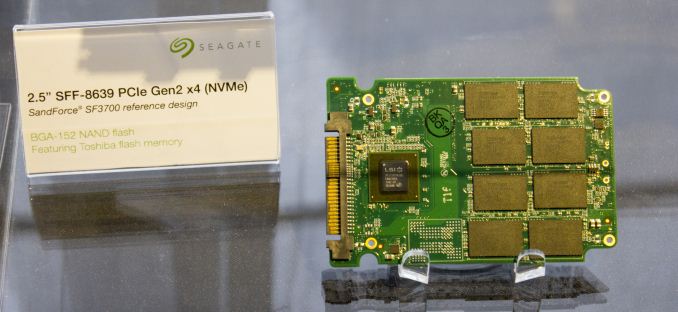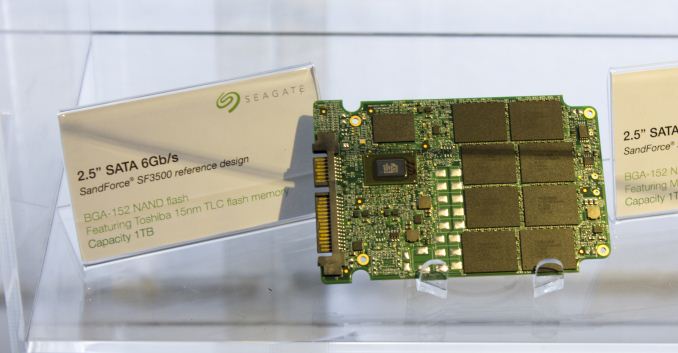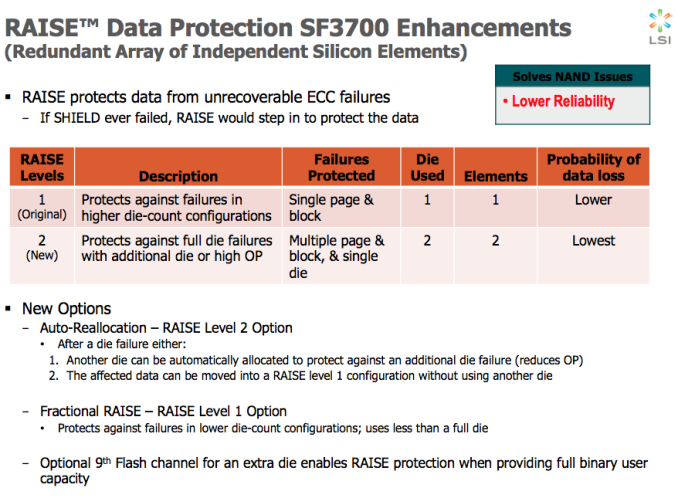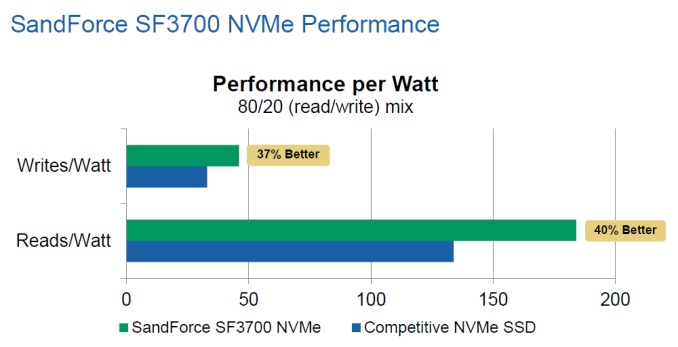Seagate Announces SandForce SF3500 SSD Controller Series: Mass Production Expected in Q4'15
by Kristian Vättö on June 10, 2015 8:25 AM EST
The SandForce SF3000 series has become the unicorn of the SSD industry. For the past two years there has been a lot of hype about the new controller, but Seagate/SandForce has kept missing deadlines one after the other. Initially the third generation SandForce controller was supposed to ship in mid-2014, but obviously that didn't happen. Next we heard Q4'15, which was then changed to mid-2015 and the latest word I got at Computex is expected mass production in Q4'15, meaning that we could see first products shipping in early 2016.
The SF3500 package is considerably smaller than the SF3700
The original paper launch back in late 2013 only included the SF3700 lineup, which was first supposed to cater all markets from entry-level client to enterprise. Last week Seagate announced that the SF3000 series has now been split into two: SF3500 for the client and SF3700 for the enterprise market. The reasoning behind the differentiation doesn't only lie in marketing as the SF3500 and SF3700 are separate dies with the SF3500 having four NAND channels whereas the SF3700 keeps the 9-channel design as announced previously. It makes a lot of sense to build a separate die for the client space and honestly I was a little skeptical about cost efficiency because it's practically impossible to build a silicon that is feature rich enough for the enterprise with a consumer friendly price tag. We've seen the client space moving towards 4-channel controller designs anyway, so I suspect introducing a smaller 4-channel controller was the only way SandForce could remain price competitive against Silicon Motion, which has taken a large share of SandForce's old clients.
| Seagate SandForce SF3000 Series Specifications | |||||
| Series | SF3500 | SF3700 | |||
| SKU | SF3514 | SF3504 | SF3524 | SF3739 | SF3759 |
| # of NAND Channels | 4 (400MT/s each) | 9 (400MT/s each) | |||
| Controller Frequency | 275MHz | 275MHz | 300MHz | N/A | N/A |
| Interface | SATA 6Gbps | PCIe 2.0 x2 (NVMe) | SATA 6Gbps + PCIe 2.0 x2 (NVMe) | SATA 6Gbps + PCIe 2.0 x4 (NVMe) | |
| Max Capacity | 1TB | 2TB | |||
| NAND Support | MLC, TLC | MLC, TLC | SLC, eMLC, MLC, TLC | ||
| Sequential Read | 550MB/s | 900MB/s | 900MB/s | 1600MB/s | 1600MB/s |
| Sequential Write | 450MB/s | 525MB/s | 525MB/s | 670MB/s | 670MB/s |
| 4KB Random Read | 100K IOPS | 130K IOPS | 130K IOPS | 130K IOPS | 130K IOPS |
| 4KB Random Write | 80K IOPS | 120K IOPS | 120K IOPS | 80K IOPS | 80K IOPS |
| Mixed 70R/30W Random | 80K IOPS | 120K IOPS | 120K IOPS | 100K IOPS | 100K IOPS |
| Encryption | AES-256, TCG Opal 2.0 & IEEE-1667 (eDrive) | AES-256 | AES-256 & TCG Entrerprise | ||
The SF3500 series includes three SKUs and similar to the SF3700 silicon the controller supports both SATA 6Gbps and PCIe 2.0 (although only two lanes, whereas the SF3700 features four). The SF3514 and SF3504 are SATA and PCIe respectively, but the SF3524 has a switch that allows it to operate in both SATA and PCIe modes similar to the SF3700 SKUs. Unfortunately the switch isn't user-accessible as it has to be toggled by the manufacturer, so it's merely a feature that helps the OEMs with inventory management. The SF3524, being the high-end model, also has more supported firmware features, but Seagate isn't disclosing any at this stage, although I was told they are more back-end related rather than concrete features that are visible to the end-user.
Inherently the SF3500 is just a 4-channel version of the SF3700 and supports all SandForce technologies (DuraWrite, SHIELD, RAISE etc), but with one twist. The SF3500 is the first time SandForce is relying on external DRAM for caching the NAND mapping table, whereas the SF3700 and all older SandForce controllers only use the integrated SRAM. No user data is stored in the DRAM, so its function is purely to increase performance as well as reduce power up time when waking the system from sleep.
Another separating feature is the RAISE support. Because the SF3500 is client-oriented, it only supports level-1 RAISE, which uses one NAND die for protection against single page/block failures (in small capacity drives fractional RAISE can be used as it requires less than a full die). The SF3700 has full RAISE support and can operate in either level 1 or 2 mode with level-2 protecting against a full die failure (the 9th channel is there for that reason).
SandForce's focus in the SF3000 series has been mixed performance from day one. While most modern drives boast excellent peak read and write performance, nearly every drive experiences notable loss in performance under mixed read/write workloads. We've been testing mixed performance as a part of our 2015 Client SSD Suite and I certainly agree with SandForce that it's an area where improvement is needed, which is what the SF3000 series is promised to do. Seagate's/SandForce's internal tests put the SF3700 at much higher performance efficiency than the competing NVMe drive that Seagate couldn't officially disclose (hint: the manufacturer starts with an I).
All in all, Seagate seems to be making progress with the SF3000 series. It's inevitably late from the original launch schedule, but on the other hand there are only a handful of client PCIe drives on the market right now, so if the new schedule sticks and the SF3000 is as good as Seagate is showing it to be, SandForce will definitely be back in the game. The Computex announcement was relatively high-level, but Seagate hinted that they will have a truckload of new details to share within the next two months, so we will stay tuned for more.




















22 Comments
View All Comments
nightbringer57 - Wednesday, June 10, 2015 - link
About the controller price, i there any source quoting the typical price distribution of the different parts for a typical consumer SSD? (I get that memory price will almost be a linear function of the capacity, but having the price distribution for a given memory capacity would already be a nice hint)Kristian Vättö - Wednesday, June 10, 2015 - link
Here's one breakdown I've seen: http://seekingalpha.com/article/2722185-nand-wars-...nightbringer57 - Wednesday, June 10, 2015 - link
Very interesting, thanks !jjj - Wednesday, June 10, 2015 - link
You might be giving too much importance to the cost of the controller.It's a pretty small controller even if on 28nm and if it ends up in high capacity drives priced at 1$ per GB then the cost of the controller is less relevant and the consumer one will fail. Folks will go with higher speeds from others and what this offers is not enough to justify the cost of an upgrade.
If it ends up in drives at 50 cents per GB then sure it makes sense but only if others can't match the price and have better perf
Senti - Wednesday, June 10, 2015 - link
Would be great controller for mid-2014 but already outdated in 2016 when everyone moves to PCIe3 x4 for performance and x1 for cost and area savings.Also, being made by Seagate expect failure rate in tens of percent on unlucky models.
Johny12 - Tuesday, June 23, 2015 - link
The comment about seagate failure rates in double digits got me wondering. I found this recent article that seems to say otherwise. https://www.backblaze.com/blog/our-6tb-hard-drive-...Magichands8 - Wednesday, June 10, 2015 - link
I just don't understand the delay to market for high capacity SSDs. I have essentially no interest in any of the SSD news that's been coming out for a while now. The read and write performance is starting to get there as we gravitate away from the limitations of SATA (it's long past time for that too) but small capacities and still way too high prices makes it a joke for me to even consider an upgrade. The problem I always face is the combining of slow, high capacities HDD's with really low capacity, high speed SSD's. Any data transfers between the two make any performance advantage of having an SSD pointless. Is the industry simply milking current technology for everything they can or are they delaying deliberately with plans to just make the jump to up-and-coming technologies like NRAM in the next year and a half? It would make some sense to not invest much more in SSD production if they were fairly certain that something that was going to blow SSDs out of the water were half-way here.mkozakewich - Thursday, June 11, 2015 - link
My first SSD was a crappy Agility (2?) in 2011, and even that budget drive cost about $120 for 60 GB. I think it was on sale, too.So... quartering the cost in four years exceeds Moore's Law. Expect $250/TB in maybe two more.
philipma1957 - Saturday, June 13, 2015 - link
Still waiting for a decent 2 tb ssd for some 1 drive systems.When will I get my 2tb sdd for 600 usd . Put it in my few pc's and not be bothered with space concerns. Right now 2012 apple mac minis allow me a 1tb ssd + 2tb hdd in a fusion drive setup . Would prefer to move on from this.
Oxford Guy - Wednesday, June 10, 2015 - link
No mention of the truly horrible unreliability of the first generation controller (especially in the Vertex 2 with 64-bit NAND) or the endless problems with TRIM of the second generation. In fact, this very site said, eventually, that TRIM just can't work properly because of Sandforce's compression scheme.So, does this new controller avoid being horribly unreliable (with a bonus "panic mode" that putting the computer to sleep randomly would lead to drive bricking) and/or incompatible with TRIM?